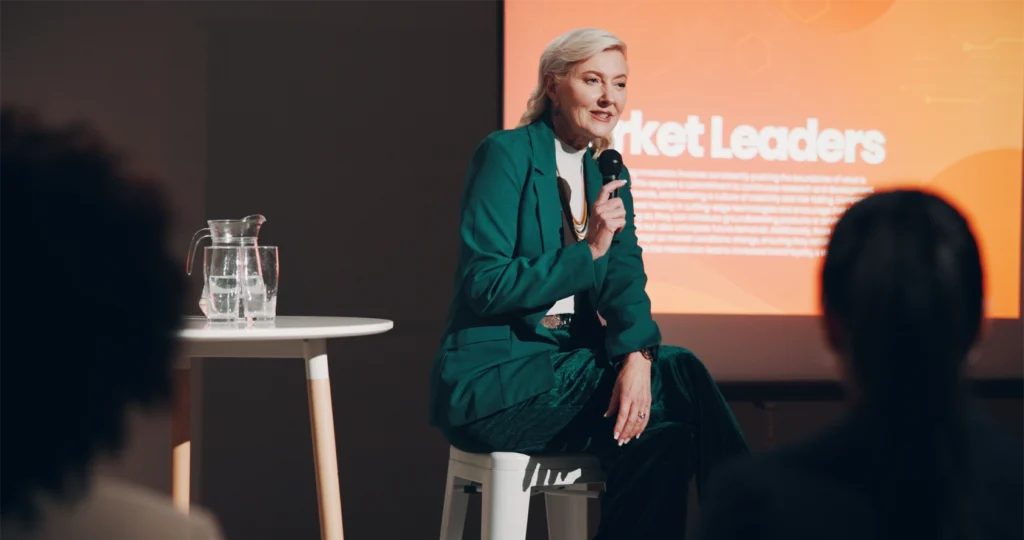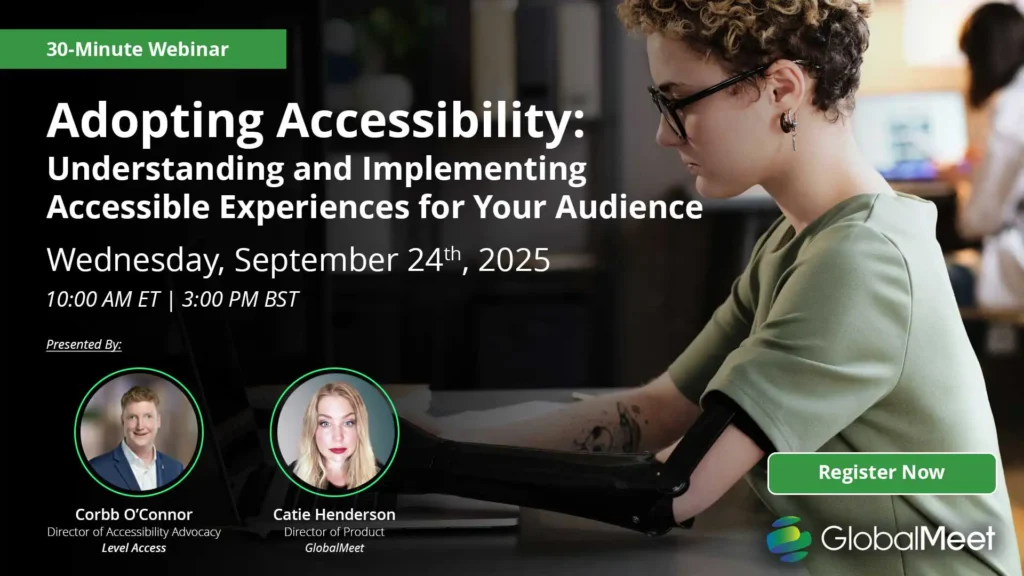
Best Practices for Presenting on a Webcast: How to Engage and Impress your Virtual Audience
- by GlobalMeet Blog Team
- ,
Whether it’s delivering investor updates, hosting a thought leadership panel, or running internal townhalls, webcasting has become an indispensable part of modern business communication.
Unlike video meetings or webinars, webcasts support corporate events at a global scale, with attendees expecting a smooth, professional, and engaging experience from start to finish.
Running a great webcast takes more than just writing a script and going live. It’s a combination of the right software, good planning and preparation, and presenters who can engage and impress even the most diverse virtual audience.
Webcast or Webinar? Know Your Format
Before planning your virtual event, it is important to understand the key differences between a webcast and a webinar. Knowing which format will best suit the content you need to deliver will help shape preparation, tone, and technical planning.
Webinars
These are usually two-way, collaborative sessions used for training and workshops. They’re best for smaller audiences and groups as they offer a wide range of options for breakouts, discussion, and in the moment teamwork.
Webcasts
Webcasts are similar to a television broadcast. They’re designed for large audiences with a one-to-many format. Most webcasts will limit who can speak and present in any given session, with interactivity managed through panel Q&A and polling rather than allowing open discussion.
Preparation. Preparation. Preparation.
Even the most experienced speakers benefit from being prepared. More than reviewing slides and checking scripts, a presenter needs to understand the platform that they’re using, get comfortable with the format, and plan as many things in advance as possible.
By defining the core message that you want to communicate, the likely expectations of the attending audience, content duration and flow, and what interactive elements should be included, a plan for the session almost builds itself.
Every audience is different, and to engage them well as a presenter it’s important to align the content and presentation style with their needs. Tailoring your presentation approach early makes planning simpler, and helps everything run smoothly on the day.
Scripts and Supporting Media
A dynamic presenter is vital for a successful webcast, but supporting media is just as important. Scripts, slides, video clips, and downloadable resources can all support and enrich the audience viewing experience, but it’s important to ensure that they don’t overshadow the presentation.
Scripts
A script can be a huge help for presenters who prefer a reminder of their content, but it’s important to avoid reading a script verbatim. Keep scripts loose, with bullet points of key information to help stay on track while keeping delivery natural.
Slides
Slides help contextualize spoken content, but they can easily become distracting. Keep visuals clean and brand aligned, with limited text so that the audience remains focused on the presenter.
Video Clips
Pre-recorded clips not only give the presenter a break from speaking, but they provide a content shift that can boost attendee engagement. If using pre-recorded clips, ensure they are tested early to check compatibility and avoid technical issues.
Rehearse and Test Early
Rehearsal is one of the most overlooked aspects of the webcast preparation process. While having tech tests and dress rehearsals might seem like something that should be done a long time in advance, the best time for a full formal run through is within a week of the go-live date. This is close enough to ensure that platform layout, controls, and content all remain familiar, and far enough away to allow for last minute glitches to be corrected.
During rehearsals:
- Be in the space that you will be in on the day
- Practice transitions between speakers and segments
- Test facilitation tools for interactive elements
- Run through the full slide deck including any video clips
- Double check branding elements and visuals appear correctly on screen
The best rehearsals are ones that test like-for like, with every condition the same as it will be on the day for maximum scenario accuracy.
Consider the Presentation Space
Not every presenter has access to a studio, but taking the time to set up a clean, professional environment can still make a huge difference.
Camera Placement and Framing
- Position your camera at eye level to give a sense of natural eye contact
- Sit centered in the frame with a good amount of space above and around you
- Avoid wide angles as these can create a feeling of distance between presenter and audience
Lighting
- Use front-facing, natural light wherever possible.
- If a room does not have good natural light, a ring light or LED panel can help create consistent lighting
- Avoid overhead or backlighting as these can create harsh shadows
Audio
- Invest in a quality microphone for best audio quality
- Test audio levels well in advance, and mute any device notifications
- Avoid using integrated laptop or webcam microphones as they can echo
Background
- Choose a neutral or branded background
- Remove artwork or clutter that might distract the audience
- Avoid any reflective surfaces
Engaging the Audience
Event engagement matters, even in a broadcast style environment. Tools that facilitate engagement activities like polls and Q&A sessions can help to keep the audience invested and make for a more successful event overall. By combining engagement elements with custom player content and storytelling, a webcast becomes more than a static viewing experience.
Polls
The best way to keep audiences engaged is to include them in the session content. Using polls to gather real time feedback and check understanding is a great way to help attendees feel like part of the event, rather than passive viewers.
Q&A Sessions
Questions can be a great tool for building a relationship between presenter and audience, while enhancing knowledge and reinforcing understanding. Assigning a designated moderator to manage incoming questions and line them up for speakers can help these sessions to flow smoothly.
Player Content
Enterprise grade platforms facilitate the inclusion of downloadable resources, custom tabs, and links with related information and further reading. These features enhance the viewer experience by adding context to the delivered content.
Storytelling
Facts tell; stories sell. It’s an old adage that remains true in the digital age. By sharing real life anecdotes, client success stories, or personal reflections you can build an emotional connection with the audience that keeps them listening to what you have to say.
Becoming a More Natural Speaker
There are some people who seem born for public speaking, but the rest of us often need a little practice. When it comes to finding confidence as a speaker and easing nerves there are numerous techniques that can help.
Speaking with Confidence
- Smiling has a number of psychological benefits for reducing stress and improving mood. It can also help you appear more open and approachable as a presenter.
- Stand up. Standing up with a strong posture doesn’t just give the appearance of confidence. Studies show that standing can also make you feel more confident.
- It might be tempting to keep your hands in your lap, but gestures can provide emphasis that makes your delivery naturally more dynamic.
Managing your Nerves
- Knowing your content and knowing it well makes it less likely that you’ll make a mistake or go off track. It can also make questions less daunting.
- Breathing deeply is inherently calming and taking a few deep breaths before you begin presenting can help settle those starting jitters.
- Speaking quickly accelerates nerves, and shows them to the audience. Practicing pauses and getting comfortable with silence can help you feel more in control.
- Be you. Audiences respond well to humanity, and nerves are human. Letting your personality come though can aid connection, and feeling connected reduces nerves.
What to do When Things Go Wrong
Even with the best preparation, things can still go wrong. Microphones cut out, slides crash, internet drops, and videos lag. So, it’s important to plan a backup in advance.
Managed webcast providers will often assign an event production team who can assist before, during, and after events with set up and running. These producers can troubleshoot in real time, handle moderation and transitions, and keep everything on track behind the scenes so presenters can focus on content.
But even with a managed service, additional backups are important. Having a copy of slides and videos to hand, a plan for switching to a new presenter if someone drops, and a backup internet connection prepared in case of failure can all help to keep an event running smoothly on the surface, even if things are going wrong behind the scenes.
Conclusion
Being a good presenter is more than being a good speaker. Engaging a virtual audience requires preparation, tech setup, and interactive elements, as well as speaker confidence. The best presenters are those who rehearse thoroughly, plan for the unexpected, and engage with attendees through story and connection. Professional and polished, even when things go wrong.
Preparing for your own webcast?
Download our Webcasting Presentation 101 quick reference guide today, and enhance your planning with a four week readiness timeline and curated expert presentation tips.

